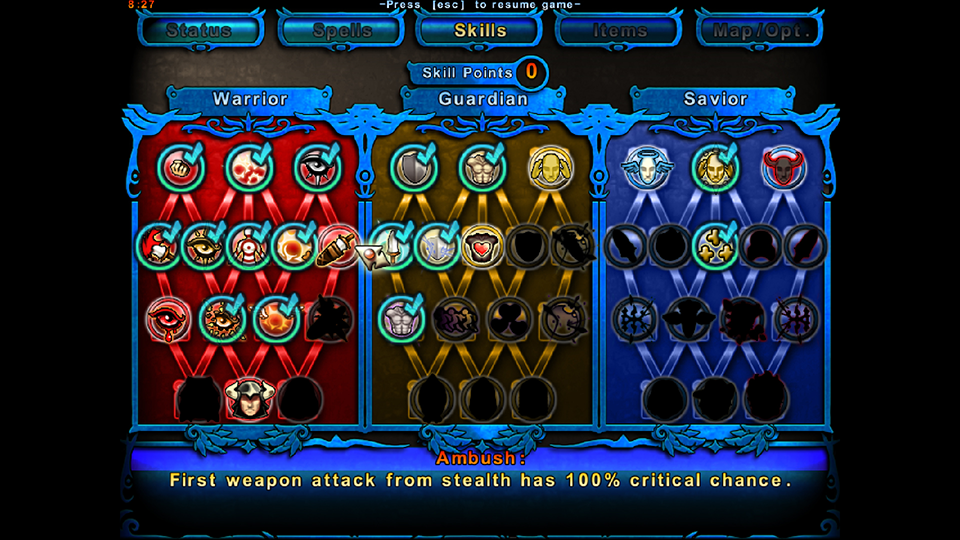That goes for the equipment too. Seriously, my first upgrade in terms of equipment came about two hours into the game, and even then the effect just didn’t really change things all that much. Further, the upgrading shops (in towns) are spread between several locations, and since the towns sprawl vertically with no shortcuts to speak of, prepare to run around finding the right person to trade for the right thing to give to another person. No easy identifying markers exist to aid the player’s way, either, which boggles my mind on so many levels This isn’t fun; it’s busywork. Add to the lack of unique effects other than statistic boosts, and you’ve really dampened my motivation to explore. I just wanted to get through non-questing areas super quickly, and they turn the whole business into a giant hassle instead.
And that leads to a further problem: the environments end up just as palette-swapped as the enemies. I found it extraordinarily hard to find my way through areas and backtrack, simply because everything felt so similar. I ended up falling into one area, and honestly couldn’t remember how to get up (because I fell down, you see). What ensued boiled down to many minutes of frustrating busywork trying to climb up (and, for whatever reason, going up a vertical area in this game proves incredibly slow), wall jump, and move my way to where I started. The map fails to tell you how areas connect very well or any other helpful details, and it just turns into a mess. Trying to figure out how a puzzle works with a useful map (and the ability to see the screen-long puzzle in full) just frustrates me to no end. Then you get a piece of Rough Cloth for that 15 minute time period when you were figuring it out with a lack of information hampered by a poor interface. Great!
With all that said, then, Valdis Story’s Metroidvania appearance lends itself into a clunky sidescrolling RPG. Honestly, discovering that focus would be totally fine, and I would accept its meager action game elements on its face. However, instead, it also has a combat system affixed to it with much more variation and skill than any other Metrodvania I’ve yet played, jumping into action-RPG territory. This, too turns quickly to disappointment when you see how little the developers seem to know what makes a Metroidvania work: flow. Combat’s obtuse, weird, clunky, unintuitive, and just about everything you don’t want to have in your exploration platforming game with light combat elements. Combat is the focus here, and if it were good I could forgive it, but it’s not.

In Valdis Story, you get your standard attack button, but it also adds a heavy attack button for combo attack. In some ways, it plays a lot like God of War, with launchers attached to the jump button in the middle of combos, and the promise of longer combo strings as you progress. At the same time, said combos do not plant you in one spot; every slash moves you forward slightly. That happens in most combat games as well, from Devil May Cry to Ninja Gaiden. However, that does not mean you copy something from a different genre WITHOUT adapting those elements to the new genre! If you don’t see how this becomes a problem in precarious platforming segments or fighting a boss on a small ledge, then you need to think about this more thoroughly.
Forward momentum in tight spots would kill you in Symphony of the Night, Strider, or similar games; that’s why the default attack button doesn’t move you at all, instead keeping your player character still (even Shantae learned this lesson well). Here, that forward motion makes you fall off ledges all the time, with no way to grab onto the platform or save yourself. The pits in this game are dangerous, and certain boss fights fill them with dangerous poison clouds that will kill you in an instant if you don’t get out of them quickly. As I mentioned before, vertical climbing takes forever in this game, and that proves true here as well. I can’t begin to tell you how awful this feels when you combo a boss only to fall down. way off a platform.
Jumping is another problem. In these sorts of games, often you can control your air trajectory very easily to land where you need to land. That goes for aerial combat as well, and attacking while jumping does not break the flow of the jumping. Here, jumping attacks kills your motion, and that means attacking poses incredible risk not commensurate to the reward. Yes, you might get a few attack off, and combating certain enemies in air remains useful, but sometimes that lack of forward motion kills you in a jump. Valdis Story tries to alleviate this somewhat by letting the player grab onto ledges and the like if you’re facing them, but it asks for pixel-perfect timing to when you grab or not. There’s no button to grab, just the context-sensitive (and, in my experience, incredibly inconsistent) whim of the game, so you can imagine, again, jumping and falling to your doom (or impending 20 minute climb, sigh). The jump heights, I would guess, are inconsistent, or the hitbox on the jumps just bounces all over the place. How insane is a platformer without consistency?! Add to the focus on grabbing ledges in general, and I think you can say definitely that these elements make Valdis Story slow and boring.
